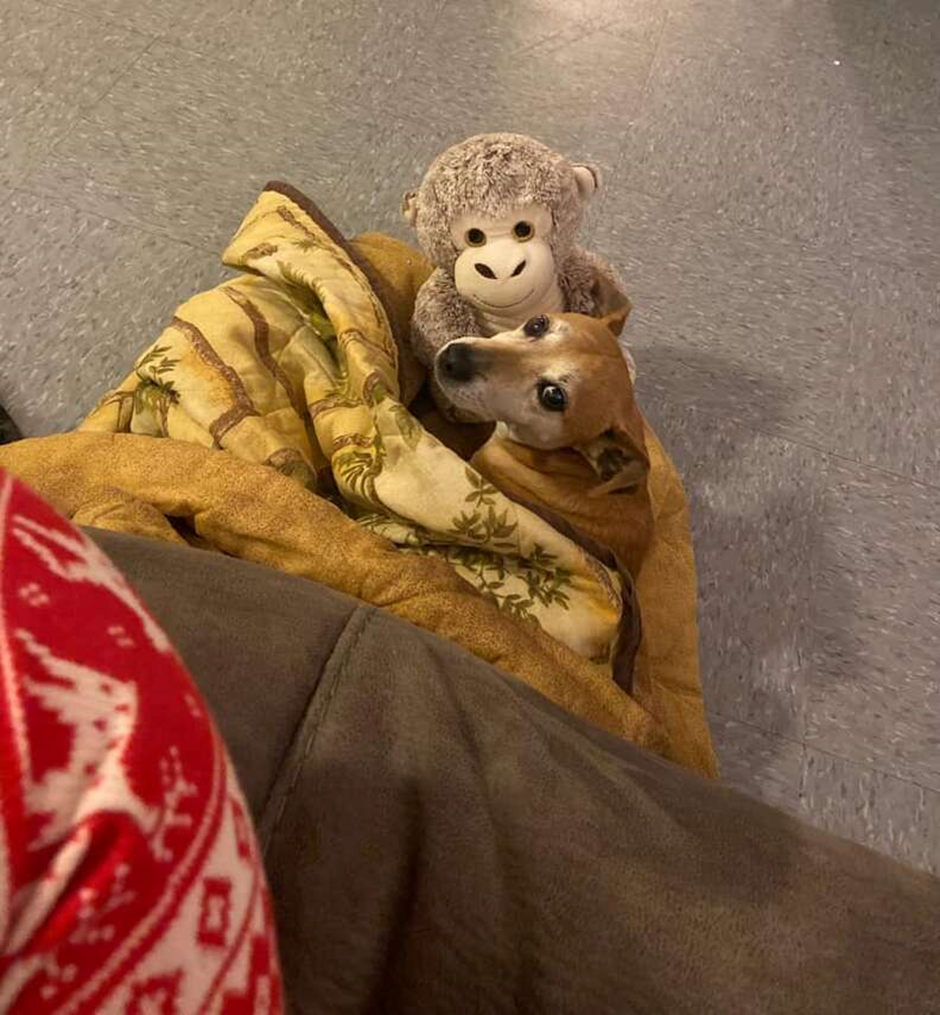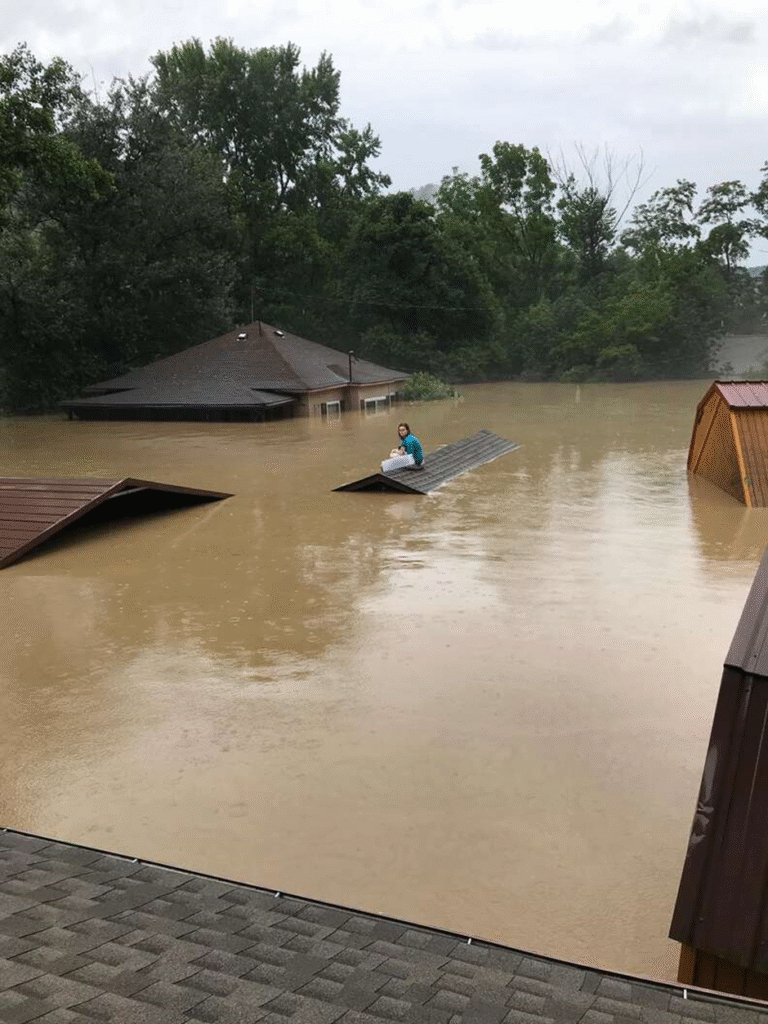The worst part about the flood wasn’t the rain itself—it was the silence that followed, quickly replaced by the terrifying, hungry sound of rushing water. My name is Maya, and I live in a quiet valley that people always called “sleepy” until the river decided to wake up. We had heard the warnings, of course, but you never truly believe it until you look out your window and see your lawn swallowed by a muddy, swirling lake. The water came fast, faster than the sirens could wail, turning our peaceful street into a treacherous, brown current.
My only concern, the only thing that mattered in the chaos, was Buddy. He’s a terrier mix, my best friend, a little dog with a heart too big for his tiny body, and the thought of leaving him was unthinkable. We had retreated to the second floor, but the water was creeping up the stairs, a silent, relentless enemy. I looked down into the brown depths swirling past the bottom step, and the reality hit me: we were trapped, and the water level was rising toward the electrical outlets. We needed to get out, and soon, but there was no way a small dog like Buddy could navigate that current. Even I was starting to shake just watching the debris rush by.
The house was filling up. Every sound—the creaking of the floorboards, the muffled roar outside—sent a spike of panic through me. Buddy, normally so cheerful, was huddled against my legs, his entire body trembling. His wide, dark eyes looked up at me, a silent, desperate plea for safety that cut right through my own fear. I knew I couldn’t carry him while trying to swim against the growing current; I needed an ark. I needed something simple, buoyant, and immediate.

My eyes scanned the attic where we had taken refuge. Old holiday decorations, dusty boxes, forgotten furniture—none of it useful. Then, tucked into a shadowy corner, I saw it: a huge, blue plastic storage container. It was the kind you used to pack away winter blankets, thick-walled and deep, easily forty gallons. It was ugly, scarred from years in the heat and cold, but right then, it looked like a lifeline. I yanked it out, the plastic scraping loudly against the wooden floor, and flipped it over.
My hands were shaking, but adrenaline took over. This wasn’t a boat, not really, but it was light, airtight, and large enough to hold Buddy securely above the water. I lined the bottom with a couple of thick, dry towels—the last vestiges of comfort we had left. Buddy watched me, confusion mixed with a hesitant curiosity in his gaze.
“Okay, Buddy,” I whispered, my voice rough, “This is our escape pod. Be brave for Mama.”
The hardest part was descending the stairs. The water was up to my knees now, frigid and powerful. I carried the heavy container down first, easing it into the floodwater gently. The bin bobbed immediately, proving its worth. The second trip was for Buddy. I scooped him up, and he tucked his head under my chin, trusting me completely. I placed him carefully inside the plastic bin. He looked tiny inside the blue walls, but immediately settled on the towels. It wasn’t the open-air exploration he was used to, but it was dry.
Then came the moment of truth. I climbed out our partially submerged living room window. The water outside was chest-high, a powerful, dark river running through my home. The current tugged fiercely at my legs, threatening to pull me under. Gripping the sturdy plastic handles of Buddy’s container, I started pushing off, battling the flow one slow, agonizing step at a time. I had to focus entirely on the bin, making sure it didn’t wobble or overturn.
The debris was a constant threat. Tree branches, bits of fencing, and whole lawn chairs swirled around us. Every time something bumped the container, my heart leaped into my throat. The water was filthy and smelled strongly of mud and fuel, a stark reminder of the danger. All I could see above the water line was the container floating next to me and the gray sky above. We pushed on for what felt like an hour, moving toward the only reliable landmark I knew: the local veterinary clinic, built on higher ground a few streets over.

Finally, after what felt like swimming a mile in lead boots, the current began to ease, and the water receded slightly. We were nearing the elevated parking lot of the clinic. The moment the bin scraped against the concrete curb, I collapsed, leaning my entire weight onto the solid ground, utterly spent.
I pulled the container fully onto the dry surface. Buddy, sensing the relief, didn’t jump out; he waited patiently as I lifted him, soaking wet and covered in mud, out of his plastic ark. The images now, after we were safe, show us clinging to that moment of reprieve. We found a semi-dry, elevated spot where I could finally sit down, exhausted, my clothes dripping and cold, but my arms securely wrapped around him.
I didn’t try to clean him or check my own scrapes. I just sat, holding him tightly, burying my face in his damp fur, feeling the steady thump of his tiny heart against my chest. That little dog, my best friend, was safe. The silence then wasn’t scary; it was the blessed silence of survival, a moment of profound gratitude. The plastic bin, the ridiculous, humble container, sat tilted beside us, an unlikely symbol of salvation.
Later, a kind rescuer snapped a quick photo of us. It shows my face, pale and streaked with mud, and Buddy nestled securely in my lap. We were still soaking wet, our exhaustion clear, but the relief was even more obvious. It wasn’t a planned photo shoot; it was the raw, undeniable proof of a promise kept.
The devastating flood may have claimed our possessions and terrorized our home, but it couldn’t touch the bond between us. All that mattered was that I had pushed that blue plastic ark through the dirty water and brought my best friend to safety. Looking back, I realize that the most beautiful things in life are often the simplest: a makeshift boat, a pair of warm towels, and the weight of your dog sleeping peacefully in your arms.


